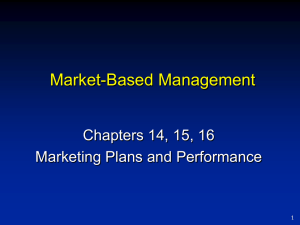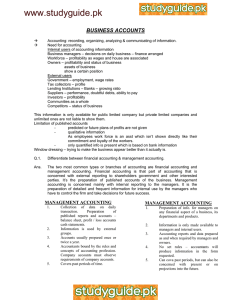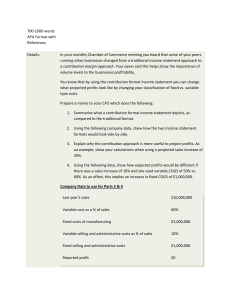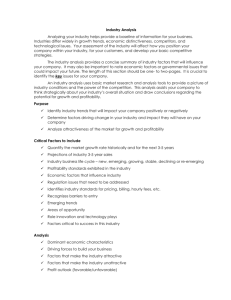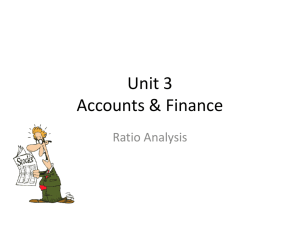Profit Centers Chapter 4 Mujtahid Subagyo
advertisement
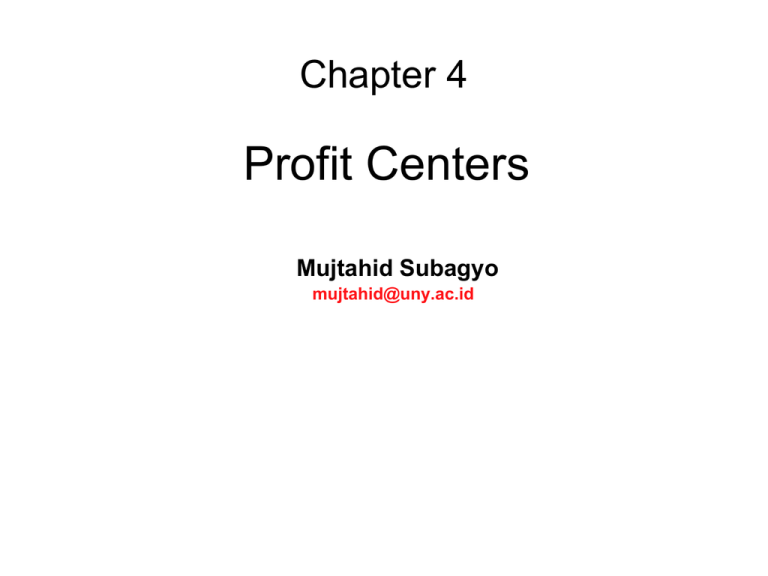
Chapter 4 Profit Centers Mujtahid Subagyo mujtahid@uny.ac.id Profit Centers • When financial performance in a responsibility center is measured in terms of profit, which is the difference between the revenues and expenses, the responsibility center is called a profit center. • Profit as a measure of performance is especially useful since it enables senior management to use one comprehensive measure instead of several measures that often point to different directions. • In this chapter, we discuss considerations involved in deciding whether profit centers should be created. The first part of the discussion focuses on constituting business units as profit centers. • Business units and profit centers are not synonymous. Even the production function or the marketing function could be constituted as a profit center. • In the second part of the discussion, we consider profit centers in organization units that are not business units. • Finally, we discuss alternative ways of measuring the profitability of a profit center. Business Unit • A functional organization is one in which each of the principal functions of manufacturing and marketing is performed by separate organization units. • When such an organization is converted to one in which each major organization unit is responsible for both the manufacturing and the marketing of a product or a family of products, the process is termed divisionalization. • In general, a company creates business units because it has decided to delegate more authority to operating managers. Some generalizations to keep in mind about organizations are: 1. All companies are organized functionally at some level. 2. The difference between a functional organization and a business unit organization is a continuum. Between the extremes of the entirely functional structure and the entirely business unit structure are all types of combinations of functional and business unit structures. 3. Complete authority for generating profits is never delegated to a segment of the business. The degree of delegation differs among businesses. Conditions for Delegating Profit Responsibility • Many management decisions involve proposals to increase expenses in the expectation of a greater increase in sales revenue; such decisions are said to involve expense/revenue trade-offs. Additional advertising expense is an example. Another example is increased quality control expense, which can result in more satisfied customers, and hence, increased revenue. • Before such a trade-off decision can be delegated safely to a lower-level manager, two conditions should exist: 1. The manager should have the relevant information to make expense/revenue trade-offs. 2. There should be some way to measure how effectively the manager is making these trade-offs. • A major consideration in identifying profit centers is to determine the lowest point in an organization where these two conditions prevail. All responsibility centers fit on a continuum ranging between those that clearly should be profit centers to those that clearly should not. Management must decide whether the advantages of giving profit responsibility offset the disadvantages. As with all management control system design choices, there is no clear line of demarcation. Prevalence of Profit Centers • Although E. I. du Pont de Nemours & Company and General Motors Corporation divisionalized in the early 1920s,' most companies in the United States remained functionally organized until after the end of World War II. Since that time many major US corporations have divisionalized and have decentralized profit responsibility at the business unit level. Alfred P. Sloan (General Motors) and Ralph J. Cordiner (General Electric) have docu­mented the philosophy of divisionalization and profit decentralization.' • A study by Govindarajan shows the extent to which Fortune 1,000 companies used the profit center concept in the 1990s. Of the 638 usable responses, 93 percent of the companies had two or more profit centers.' In many respects, this study was similar to the one conducted by Vancil' as well as the one conducted by Reece and Cool.' Because of the over 15-year gap between the Govindarajan survey and the Vancil and Reece and Cool surveys, we use the rel­evant findings from the three surveys in Chapters 4, 5, and 6 to identify any significant changes in companies' approaches to profit center measurement during the past 15 years. Advantages of Profit Centers • The speed of operating decisions may be increased because many decisions do not have to be referred to corporate headquarters. • The quality of many decisions may be improved because they can be made by the managers closest to the point of decision. • Profit consciousness may be enhanced. Managers who are responsible for profits will be looking constantly for ways to improve them. For example, a manager who is responsible only for marketing activities will be motivated to make sales promotion expenditures that maximize sales, whereas a manager who is responsible for profits will be motivated to make sales promotion expenditures that maximize profits. Advantages of Profit Centers • Headquarters management may be relieved of day-to-day decisions and can, therefore, concentrate on broader issues. • Measurement of performance is broadened. Profitability is a more comprehensive measure of performance than the measurement of either revenues or expenses sep­arately. It measures the effects of management actions on both revenues and expenses. • Managers, subject to fewer corporate restraints, should be freer to use their imagination and initiative. Advantages of Profit Centers • A profit center provides an excellent training ground for general management. Because a profit center is similar to an independent company, its manager is trained in managing all the functional areas. At the same time, the profit center provides an excellent means for evaluating the manager's potential for higher management jobs. • If a company has a strategy of diversification, profit center structure facilitates use of different specialists/experts in different types of businesses. For example, people who are best trained in managing a certain type of business can be assigned to work exclusively in that business if it is a separate business unit. • Divisionalization provides top management with information on the profitability of components of the company. • Profit centers are subject to pressures to improve their competitive performance. Difficulties with Profit Centers However, the creation of a profit center may cause difficulties: • To the extent that decisions are decentralized, top management may lose some control. Relying on control reports is not as effective as personal knowledge of an operation. With profit centers, top management must change its approach to con­trol. Instead of personal direction, senior management must rely, to a considerable extent, on management control reports. • Competent general managers may not exist in a functional organization because there may not have been sufficient opportunities for them to develop general management competence. Difficulties with Profit Centers • Organization units that were once cooperating as functional units may now com­pete with one another. An increase in one manager's profits may decrease that of another. This decrease in cooperation may manifest itself in a manager's unwill­ingness to refer sales leads to another business unit, even though that unit is better qualified to follow up on the lead, in production decisions that have undesirable cost consequences on other units, or in the hoarding of personnel or equipment that, from the overall company standpoint, would be better off assigned to, or used in, another unit. • Friction can increase. There may be arguments over the appropriate transfer price, the assignment of common costs, and the credit for revenues that were generated jointly by the efforts of two or more business units. Difficulties with Profit Centers • There may be too much emphasis on short-run profitability at the expense of long-run profitability. In the desire to report high current profits, the profit center man­ager may skimp on R&D, training programs, or maintenance. This tendency is especially prevalent when the turnover of profit center managers is relatively high. In these circumstances, managers may have good reason to believe that their actions may not affect profitability until after they have moved to other jobs. • There is no completely satisfactory system for ensuring that each profit center, by optimizing its own profits, will optimize company profits. Difficulties with Profit Centers • If headquarters management is more capable or has better information than the average profit center manager, the quality of some of the decisions may be reduced. • Divisionalization may cause additional costs because it may require additional management, staff personnel, and recordkeeping, and may lead to redundant tasks at each profit center. Business Unit • Constraints on Business Unit Authority – Constraints from other business units – Constraints from corporate management Other Profit Centers • Functional Units – Marketing – Manufacturing – Service and support units • Other Organizations Measuring Profitability Measuring Profitability • Types of Profitability Measure – Contribution Margin – Direct Profit – Controllable profit – Income before taxes – Net Income Measuring Profitability • Bases of Comparison Measuring Profitability • Management Considerations
